"It’s so clean here. The streets are so nice. The air so fresh.” I gushed constantly the first three days to Chiba, my Ugandan cousin and travel companion; I think she was starting to get annoyed.
I could sense right away that what I had heard of Rwanda was true: they don’t tolerate corruption. I could actually see foreign aid and domestic investment going to work: paving roads, stocking clinics, building schools, not lining fraudulent pockets. The discipline and honesty inspires and gives hope to the continent. And it makes the corruption in Uganda even more blatant, elucidating its negative effects. I would look around Rwanda and think, Look at what Uganda could have if the government served its people like this.
The current political wind pacifies the land too, attempting to blow away the country’s infamous tribal tensions. Decades of hatred between the Tutsis and Hutus coalesced in an apocalyptical slaughter fifteen years ago, leaving a stain on the country, the region, and the world’s conscious. It lingers, but has become an impetus for change.
“There are two tribes here, right? But you speak one language?” Chiba had asked a Rwandan, trying to grasp the region’s unusual historical sharing of a single language between tribes.
“No. There is one tribe,” the woman said firmly, holding up a single finger. Chiba and I exchanged a glance; we understood what the woman was telling us.
As explained to me by a Rwandan close with the Balazas whom I met in Kigali, tribal differences remain, but are conducted secretively as they are acknowledged to be amoral and are even illegal. Tutsi parent’s may not want their children marrying Hutus and vice versa, but preferences are not always enforced, and if they are, are generally done covertly. One tribe may have a bar that is a hang-out, an area that is known to be theirs, but boundaries are mostly unsaid and the society is working hard to erase their divisions and nightmarish past. Hutus and Tutsis work and live side-by-side, they sometimes inter-marry; they are fighting for justice and forgiveness despite decades of animosity percolating below the surface unseen by visitors, but divulged in cover of darkness, in the confines of friendship.
Beyond Hotel Rwanda

It is still an operating hotel in the center of Kigali and is actually larger than it seemed in the film. The movie communicated to the world a story very much deserving to be told, the actions of a courageous Hutu who risked death hiding over a thousand Tutsis and moderate Hutus in the hotel. Larger than art, the film has metamorphosed into more than cinema; it is now how the world understands the Rwandan genocide, how the public seems to relate to all of Rwanda. But Hotel Rwanda, despite its paramount artistic integrity, is not the complete picture of the holocaust, and certainly not all that is Rwanda past and present.
As historical background to the genocide, the Belgians colonized Rwanda and exacerbated the differences between the Hutus and Tutsis by issuing identity cards and favoring the minority Tutsis, offering them better educational and employment opportunities. Upon the country’s independence in 1962, the Hutus assumed power and enacted revenge against their brother tribe through subjugation and smaller, lesser known genocides. Many Tutsis fled their home during these decades to neighboring countries, including Uganda. These Tutsi refugees as well as some moderate Hutus came together to form the Rwandan Patriotic Front (RPF), which grew in power in the early 1990s and sought to overthrow then Rwandan President, Juvenal Habyarimana.
Then, on April 6, 1994, President Habyarimana’s plane was shot down over Kigali airport. It is still unclear who shot it: the RPF, or extremist Hutus who wanted to blame the RPF as an excuse to begin the slaughter, most believe it the latter. Regardless of who killed the President, it was an impetus for mass death.
Beginning the night the plane was shot down until mid-July of 1994, nearly one million Tutsis and moderate Hutus were murdered while the world largely stood and watched; nearly 20% of the nation’s population; 10,000 murdered every day, 400 every hour, 7 every minute. It is estimated that about 300,000 Tutsis survived the genocide, including thousands of HIV-positive widows, many of whom were subjected to genocidal rape by men known to have the virus. The genocide also left about 400,000 orphans with nearly 85,000 of them becoming heads of households.
Wreath and flowers at mass graves at Kigali Memorial
The Kigali Memorial is a museum dedicated to the country’s dark past. The bottom rooms describe the historical context, and contain some footage of the massacre as well as interviews with survivors. The upstairs contains countless pictures of the deceased, photographs donated by their living relatives. A section is dedicated to the children. Larger than life photos of children line the walls with a placard describing them underneath: their names, their likes, their last words, how they died: an infant burned to death in a church, a four-year old liking spaghetti, a two-year old murdered by being thrown against a wall, a seven-year old last heard saying “UNAMIR will save us,” a ten-year old tortured to death.
The survivors will say they have no idea how they endured; it was mere luck, an act of God. Few were blessed with a courageous Hutu that hid them, chancing his or her own life to save another, but most fled. Families would part and run for cover, generally unable to hide together as the roadblocks strategically placed around Kigali and the entire country prevented it. As such, the youngest were destined to die, unable to run through the bush by themselves. My Rwandan friend tells me the youngest survivor running alone that he heard of was seven.
skulls at Murambi Memorial
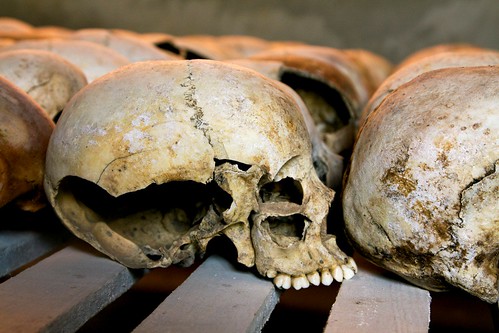
As I walked the streets of Kigali and drove through the villages, I would look at people and wonder where they were during the killing. Were they here in Rwanda? Or were they already seeking refuge in a neighboring country? The people my age would have been about 15 or 16 years old during the genocide. What did I do at that age? School dances, soccer games, getting a driver’s license, going to parties, sleeping in class. While I danced, played, drove, partied and slept, the Rwandans my age whom I saw in cafes and the fields, at market and the bus stop, might have murdered or been hunted, watched their family members kill or be killed, walked around bodies littering the ground or buried the dead. What had I done with my life since my mid-teens? University, jobs, love, friends, birthdays, Christmases. I think of the thousands of lives lost before they could experience this, before they really lived.
I considered this too at the Murambi Memorial in Gikongoro, a former technical college resting alone on a hill just outside the nondescript town. Chiba and I reached Gikongoro via bus from Kigali in the late morning, and asked a boda to take us the memorial; a creeping eeriness descending upon us as we fell down the dirt road and peered through the eucalyptus at the striking countryside, not knowing where we headed, unsure of what we would see. A white jeep passed us with a mzungu in the back, staring out the window, a memorable expression on her face: regret, forlorn, shock, hurt.
The memorial was off the path traveled by most tourists making it a somewhat obscure destination. It lacked the sense of a formal remembrance center besides the entrance sign and reception desk; it felt like an abandoned set of buildings lying to waste on the hillside forgotten.
As we approached the entrance, a woman spoke in hushed tones to Chiba, joining her by hand as we wound around to the back side towards a series of smaller brick buildings, beyond us the flowing, terraced mountains of Rwanda; austere beauty.
Room after room we took in the dead on display. Approximately 50,000 people died at Gikongoro’s technical school, only a small fraction, about two hundred are preserved in the memorial, most buried beneath the ground forever. All of the children and staff at the school perished as well as the nearby villagers who ran to the blocks for safety.
We entered the old dormitory block, a huge empty space save a wall filled with the dead’s crumpled possessions: mattresses, blankets, clothes, shoes, bowls, cutlery. I believe it was here that our guide whispered to Chiba. Two of my children died here.
She walked us down the slope towards the far side of the property, about 50 yards away the first set of houses lay below us, two children ran up to me from them and asked for money. I looked at another placard before me, The French played volley here. I didn’t fully grasp the purpose.
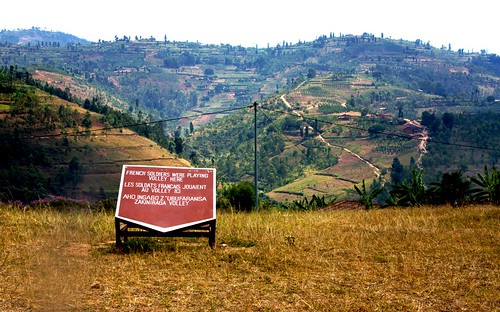
They walked us down another 15 yards then I saw a series of other placards: Mass Graves of Victims. I now understood the placards.
On June 22, 1994, with no end of the blood-shed in sight, the UN green-lighted the deployment of a French peacekeeping troop to secure areas in southwestern Rwanda as safe zones for fleeing Tutsis. The operation is now generally regarded, except for by the French, as a move to provide haven not for hunted Tutsis, but instead for the murderous Hutus escaping retribution from the advancing RFP; the French were giving protection to the Hutu militia groups they had been covertly siding with and arming all along.
To Clementine
Berra entered the room, a source of light, the woman exuding compassion and inspiration. We took photos with the staff and went up to Berra’s office for a long chat about the program, the import of building nations through assisting women, the significance of ethical leadership, Rwanda’s battle for justice and growth, and the burning passion and drive within to serve others. Berra spoke of herself as a young girl trying to help an old woman and the refugees and destitute around her, coming home and crying to her mom about them. She laughed looking back on it. She didn’t’ even see how poor her own family was.
That Friday we met at WWI’s office and boarded a van, which drove about two hours south of Kigali. We stopped just off the main road near the top of a mountain. Above us a large group of women, a few hundred, standing, pacing, looking eagerly into our vehicle.
“They are excited you are here. They never get to see their sponsors. This is very rare," one of the trainers explained to me as I watched them watching me.
Then a trainer to my side smiled broadly, gestured behind me and said, “Here she is.”
Clementine let go to look at me then held me again. She introduced me to her husband shyly standing next to her wearing a huge grin. He hugged me timidly and happily, thanking me in his language.
Then Clementine offered a gift. In her hands lay a small green and white beaded box and a pink and black beaded necklace. I thanked her profusely. Her husband and she tied the jewelry around my neck. I wore a half smile, touched by the gesture, but anguished with guilt. She had sacrificed several dollars, probably as much as she makes in as many months to give me a present and in my haste I had brought her nothing. Others later assured me. It was a gift you coming to see her. It inspires.
Clementine walked back towards the others as they broke off into the groups for the day’s lesson on nutrition. The women around us draped in bright colors, some shielded from the sun under rainbowed umbrellas continued to talk.
"Do you know what they are saying?” the trainer asked me.
“I have no idea.”
“They say it is a miracle. You coming. Her meeting her sister. They are very happy for her.”
I was humbled.
“I delivered your letter to Clementine today.”
We sat in silence.
Then Chiba muttered under her breath, “It is a miracle.”
I remained quiet; stared out the window; reflecting on an unforgettable day.

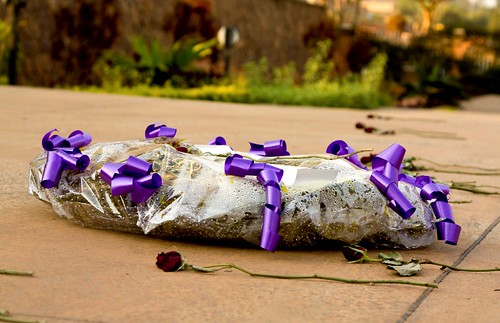


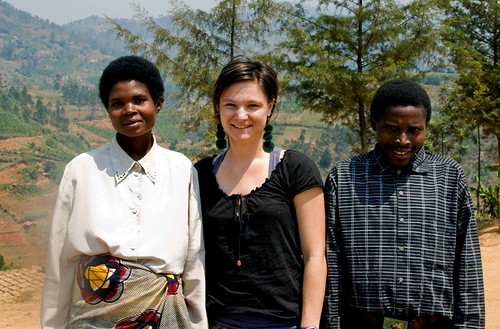
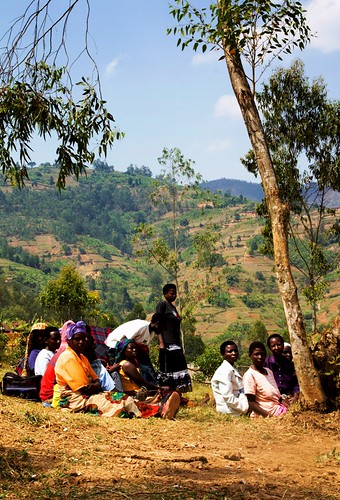
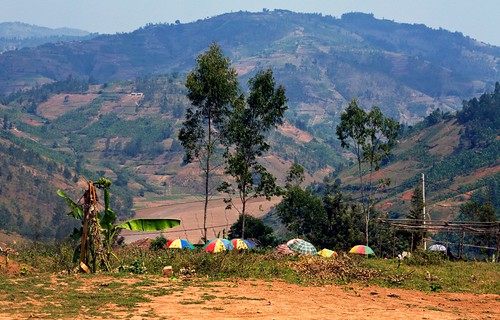

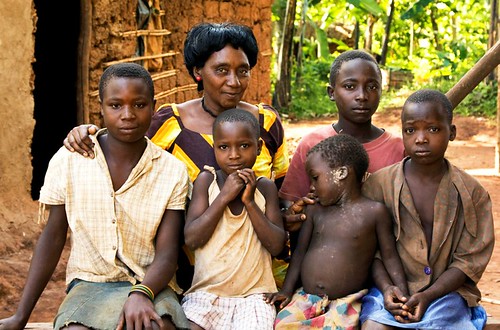






Never forgotten! Thanks for sharing!
ReplyDelete-h